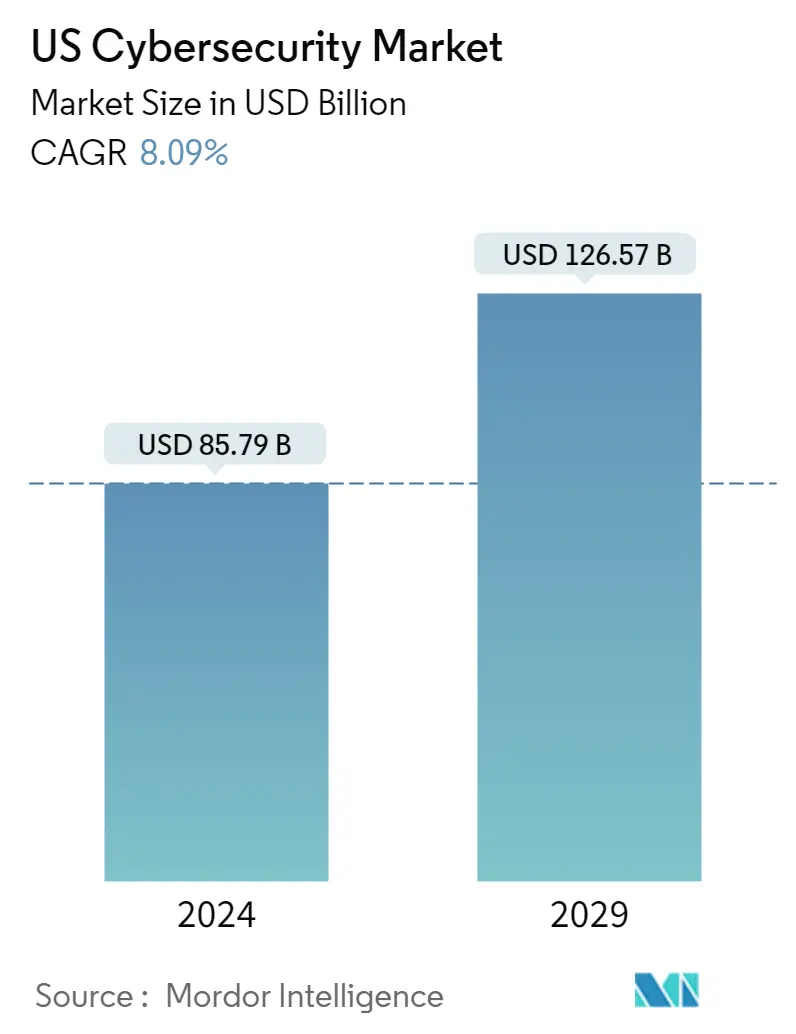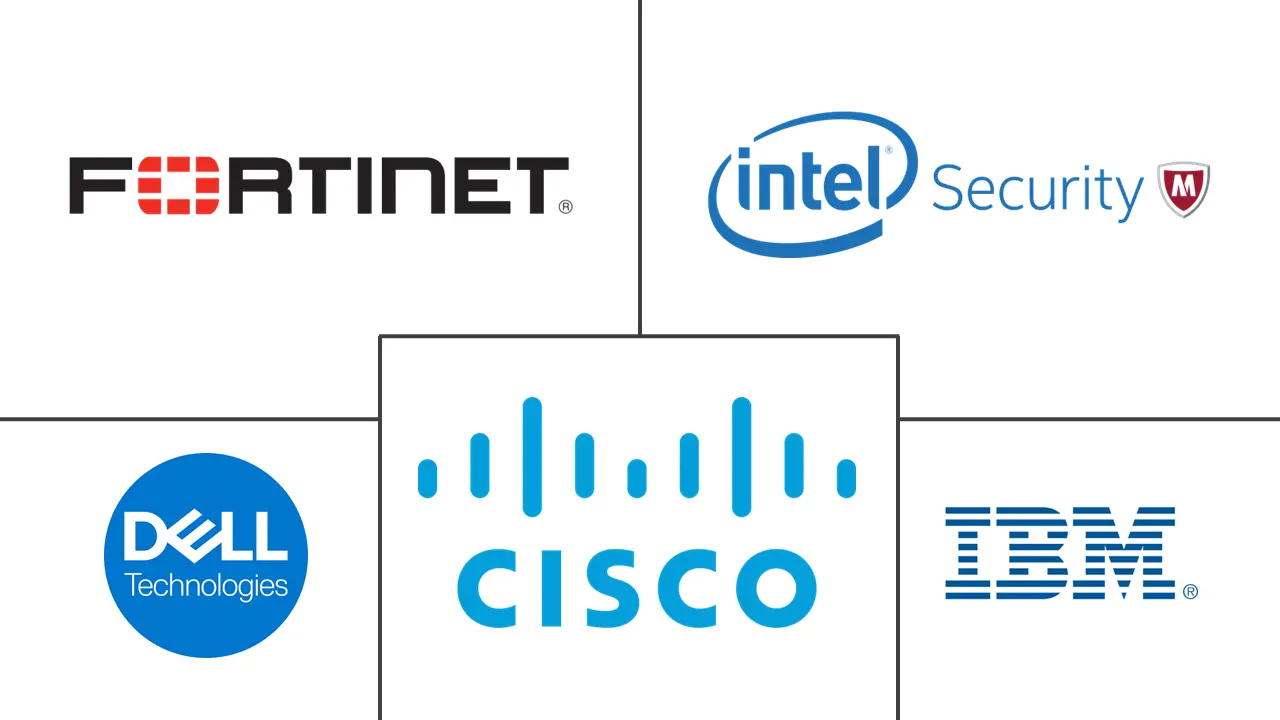Market Size of US Cybersecurity Industry

| Study Period | 2019 - 2029 |
| Base Year For Estimation | 2023 |
| Market Size (2024) | USD 85.79 Billion |
| Market Size (2029) | USD 126.57 Billion |
| CAGR (2024 - 2029) | 8.09 % |
| Market Concentration | Medium |
Major Players
*Disclaimer: Major Players sorted in no particular order |
US Cybersecurity Market Analysis
The US Cybersecurity Market size is estimated at USD 85.79 billion in 2024, and is expected to reach USD 126.57 billion by 2029, growing at a CAGR of 8.09% during the forecast period (2024-2029).
The difficulty of protecting against a persistent information security breach is one that businesses in all industries in the United States are currently confronting. To fight against incoming threats and safeguard sensitive data, security experts are expected to keep ahead of dangers and use technologies, policies, and processes. Additionally, enterprises need to be able to swiftly and securely modify their core business applications across on-premise, SDN, and cloud environments as they speed up their digital transformation activities. This means that to manage these operations, IT and security teams need to have a complete awareness of fine-grained control over their whole network architecture.
- The market's expansion might be ascribed to the sophistication of cyberattacks, which is rising. Over the past ten years, the number and severity of cybercrimes and scams have escalated, causing enormous losses for enterprises. As cybercrimes have dramatically escalated, businesses have focused their expenditure on information security solutions to bolster their internal security infrastructures. The use of targeted assaults, which penetrate targets' network infrastructure while remaining anonymous, has increased recently. Endpoints, networks, on-premises devices, cloud-based apps, data, and numerous other IT infrastructures are frequently targeted by attackers who have a specific target.
- For instance, in March 2021, Hackers targeted four security flaws in Microsoft Exchange Server email software; they used the bugs on the Exchange servers to access email accounts of at least 30,000 organizations across the United States, which included small businesses, towns, cities, and local governments. The attack allowed the hackers to remotely control the affected systems, allowing them access to potential data theft and further compromise.
- Following a public call asking government agencies in the region to join forces with the private sector and academia to ensure that medical facilities are protected from cyber threats. Various collaborations have been taking place in the industry. For instance, in March 2022, Senators of the United States Parliament introduced Healthcare Cybersecurity Act. The Act aims to promote collaboration between Cybersecurity and Infrastructure Security Agency (CISA) and HHS to enhance cybersecurity efforts across the healthcare and public health sector.
- In January 2022, the federal banking regulators of the United States issued a cybersecurity rule requiring prompt notification of a breach. The proposed rule is poised to provide the agencies with an early warning of considerable computer security incidents. It would need notification as soon as possible and no later than 36 hours after a banking enterprise determines that an incident has occurred. Such regulations could control the cyber attacks in the banking sector of the United States.
- According to the US Department of Homeland Security (DHS) Cybersecurity, there has been a sharp increase in phishing and malware distribution using COVID-19-themed lures, the registration of new domain names containing words related to coronavirus or COVID-19, and attacks against recently and swiftly deployed remote access and teleworking infrastructure. As businesses prepare to implement months-long business continuity plans (BCP), including information security monitoring and response while working under quarantine circumstances, focusing on increasing cybersecurity, the pandemic has further expedited the need for cybersecurity.
US Cybersecurity Industry Segmentation
Cybersecurity solutions help an organization to monitor, detect, report, and counter cyber threats that are internet-based attempts to damage or disrupt information systems and hack critical information using spyware and malware, and by phishing, to maintain data confidentiality. The United States Cybersecurity Market is segmented by Offering ( Security type (Cloud, Data Security, Identity Access Management, Network Security, Consumer Security, Infrastructure Protection), Services), by Deployment (Cloud, On- Premise) and by End User ( BFSI, Healthcare, Manufacturing, Government and Defense, IT and Telecommunication). The market sizes and forecasts are provided in terms of value (USD) for all the above segments.
| By Offering | |||||||||
| |||||||||
| Services |
| By Deployment | |
| Cloud | |
| On-premise |
| By End User | |
| BFSI | |
| Healthcare | |
| Manufacturing | |
| Government & Defense | |
| IT and Telecommunication | |
| Other End Users |
US Cybersecurity Market Size Summary
The US cybersecurity market is experiencing significant growth, driven by the increasing sophistication and frequency of cyberattacks. As businesses across various sectors grapple with the challenges of safeguarding sensitive information, there is a heightened focus on implementing robust cybersecurity measures. This includes the adoption of advanced technologies, policies, and processes to protect against persistent threats. The rapid digital transformation across the country has further underscored the importance of cybersecurity, with enterprises needing to secure their core business applications across on-premise, SDN, and cloud environments. The market's expansion is also fueled by the growing need for identity and access management solutions, as organizations strive to enforce stringent access controls and protect against identity thefts, particularly in the banking and payment industries.
The BFSI sector, in particular, faces a myriad of cyber threats due to its vast customer base and the sensitive financial information it handles. Cybercriminals are increasingly targeting this sector with sophisticated attacks, prompting financial institutions to adopt proactive security measures and comply with regulatory requirements. The rise of ransomware and phishing attacks has further intensified the demand for cybersecurity solutions, as financial firms seek to protect themselves and their customers from potential breaches. The market is moderately consolidated, with major companies and SMEs investing in strategic partnerships and product developments to enhance their market presence. Recent acquisitions, such as Google's acquisition of Mandiant, highlight the ongoing efforts to strengthen cybersecurity capabilities and address the evolving threat landscape.
US Cybersecurity Market Size - Table of Contents
-
1. MARKET INSIGHTS
-
1.1 Market Overview
-
1.2 Value Chain Analysis
-
1.3 Porter's Five Forces Analysis
-
1.3.1 Threat of New Entrants
-
1.3.2 Bargaining Power of Buyers
-
1.3.3 Bargaining Power of Suppliers
-
1.3.4 Threat of Substitutes
-
1.3.5 Intensity of Competitive Rivalry
-
-
1.4 Impact of Covid-19 on the Market
-
-
2. MARKET SEGMENTATION
-
2.1 By Offering
-
2.1.1 Security Type
-
2.1.1.1 Cloud Security
-
2.1.1.2 Data Security
-
2.1.1.3 Identity Access Management
-
2.1.1.4 Network Security
-
2.1.1.5 Consumer Security
-
2.1.1.6 Infrastructure Protection
-
2.1.1.7 Other Types
-
-
2.1.2 Services
-
-
2.2 By Deployment
-
2.2.1 Cloud
-
2.2.2 On-premise
-
-
2.3 By End User
-
2.3.1 BFSI
-
2.3.2 Healthcare
-
2.3.3 Manufacturing
-
2.3.4 Government & Defense
-
2.3.5 IT and Telecommunication
-
2.3.6 Other End Users
-
-
US Cybersecurity Market Size FAQs
How big is the US Cybersecurity Market?
The US Cybersecurity Market size is expected to reach USD 85.79 billion in 2024 and grow at a CAGR of 8.09% to reach USD 126.57 billion by 2029.
What is the current US Cybersecurity Market size?
In 2024, the US Cybersecurity Market size is expected to reach USD 85.79 billion.

